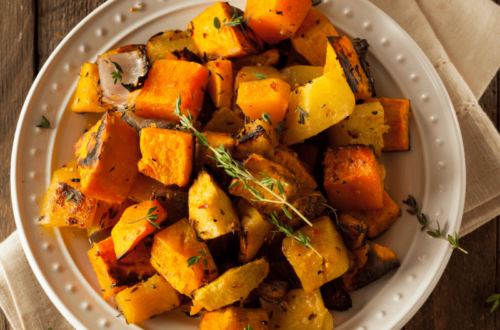
A Beginner’s Guide to Carb Cycling + 30 days of Recipes
The ketogenic diet has been gaining a lot of popularity in recent years, and for good reason. It can help you lose weight, improve your overall health, and more! The only downside is that it can be difficult to follow if you don't know what to eat or how much. Carb cycling is an easier way to achieve the benefits of the keto diet without all of the work involved. This post will give you everything you need to know about carb cycling so that you too can start living a healthier life today!
What is the Carb Cycling Diet??
The carb cycling diet is a low-carb, high-fat weight loss strategy that combines periods of strict keto with scheduled breaks from the diet to maintain your sanity. Carbohydrate intake on these days should be kept below 50 grams for women and 100 grams for men. The goal here isn't necessarily fat or calorie restriction but more about maintaining muscle mass while getting enough carbs to boost performance in the gym and power through intermittent fasting without malaise.
It's also worth noting that this type of eating pattern can help protect against many chronic illnesses such as diabetes, heart disease, metabolic syndrome (insulin resistance), and others because it helps balance insulin levels by providing regular carbohydrate refeeds every few weeks when you are restricting carbohydrates most of the time.
How is carb cycling different than the keto diet?
The main difference between carb cycling and a strict ketogenic diet is that you get more carbs when you are not following the ketogenic diet. This means for those who have been on the low-carb, high-fat plan for an extended period of time but found it difficult to sustain without a break from carbohydrate intake once in awhile or want to perform better at sports they will be able to take advantage of this strategy by getting even just 50 grams per day during the less restrictive periods.
Additionally, your body also gets some protection against many chronic illnesses including diabetes (which can develop as a side effect of long-term ketosis), cardiovascular disease, metabolic syndrome (insulin resistance), etc. This happens because carb cycling provides regular carbohydrate refeeds every few weeks when you are restricting carbs most of the time so your body has a chance to rest and recover from all that hard work keeping up with ketogenic dieting.
What is the downside of carb cycling?
The only real significant downside could be if someone ate too many carbohydrates on their "off" days, which would negate any health benefits they gained during those times. The goal isn't necessarily fat or calorie restriction but about maintaining muscle mass while getting enough carbs to boost performance in the gym and power through intermittent fasting without malaise.
It also helps protect against many chronic illnesses such as diabetes (which can develop as a side effect of long term ketosis), cardiovascular disease, metabolic syndrome (insulin resistance), because it balances insulin levels by providing regular carbohydrate refeeds every few weeks when you are restricting carbs most of the time.
What are the benefits of carb cycling?
Carb cycling can help boost performance in the gym, power through intermittent fasting without malaise, maintain muscle mass while getting enough carbohydrates to improve your overall health including diabetes as a side effect from long-term ketosis, cardiovascular disease, metabolic syndrome (insulin resistance), etc. It also helps protect against chronic illnesses such as these due to the fact that it balances insulin levels by providing regular carbohydrate refeeds every few weeks when you are restricting carbs most of the time.
The only real significant downside could be if someone ate too many carbohydrates on their "off" days, which would negate any health benefits they gained during those times. The goal isn't necessarily fat or calorie restriction but about maintaining muscle mass while getting enough carbs to boost performance in the gym and power through intermittent fasting without malaise.
It also helps protect against many chronic illnesses such as diabetes (which can develop as a side effect of long term ketosis), cardiovascular disease, metabolic syndrome (insulin resistance), because it balances insulin levels by providing regular carbohydrate refeeds every few weeks when you are restricting carbs most of the time.
Tips for Carb Cycling
-Eat a low carbohydrate diet on most days of the week and enjoy your favorite carbs for one meal per day.
-The best time to eat these carbohydrates is post-workout or as an evening snack, it will help restore muscle glycogen levels so you can start off with a better baseline in the morning without crashing later on from not having enough energy.
-Eating carbohydrates at night before bed may also improve sleep quality because they stimulate serotonin production which causes melatonin release that helps regulate our biological clock according to seasons.
-eat more vegetables than fruit - especially when following ketogenic diets where insulin inhibiting foods are typically recommended (i.e., avocados). The high sugar content in fruits can cause a spike and then crash, which might not be ideal for long-term weight maintenance. If you plan to continue with carb cycling after reaching your desired goal weight, lower the number of carbs eaten on off days until it's easier to maintain your new body composition without added sugars or other carbohydrates that increase cravings and blood glucose levels.
How long should I carb cycle?
If you're looking to lose weight, carb cycling could be used until reaching your desired goal weight. If maintaining weight is important, it would be recommended to continue with carb cycling until long-term weight maintenance is reached.
30 Days of Carb Cycling Meal Plan
30 Days of Carb Cycling Breakfast Recipes
- Keto Savory Breakfast Cookies from Chasing a Better Life
- Creamy Bacon Egg Cups from Whole Lotta Yum
- Keto Egg Wraps with Spinach, Avocado, & Bacon from Chasing a Better Life
- Mexican Breakfast Bowls from Keto Connect
- Keto Avocado Cheddar Breakfast Sandwich from Chasing a Better Life
- Sausage Ball Puffs from Kasey Trenum
- Keto Southwestern Breakfast Skillet from Chasing a Better Life
- Keto Feta and Bacon Breakfast Bake from Chasing a Better Life
- Keto Cinnamon Roll Pancakes with Cream Cheese Frosting from Broke Foodies
- Keto French Toast Egg Loaf from Chasing a Better Life
- Oven Baked Eggs from Savor + Savvy
- Baked Eggs in Ham Cups from Oh Snap! Let’s Eat!
- Low Carb Breakfast Casserole from The Diary of a Real Housewife
- Eggs in a Basket from Inspired Edibles
- Baked Eggs in Avocado from Pop Sugar
- Chicken and Apple Sausage from PaleOMG
- Kale and Chives Egg Muffins from Paleo Flourish
- Sausage Crusted Egg Muffins from Joy Filled Eats
- Cheesy No Egg Sausage Mushroom Breakfast from Kalyn’s Kitchen
- Baked Tomato and Egg Breakfast from Fed + Fit
- Instant Pot Coconut Low Carb Porridge from Low Carb Yum
- Chorizo and Pepper Egg Muffin Cups from Keto Cooking Christian
- Cauliflower Hash Browns from Keto Connect
- Low Carb Pumpkin Waffles from Noshtastic
- Low Carb Bagels from Wholesome Yum
- Keto Oatmeal from Screwed on Straight
- Breakfast Chili | Jones Dairy Farm
- Bacon Guacamole Fat Bombs from Keto Diet App
- Herb Baked Eggs from Dragon’s Kitchen
- No Bake Cinnamon Vanilla Breakfast Protein Bites from Cotter Crunch
- Pancakes from Wicked Stuffed
- Blueberry Pancakes from Keto Cooking Christian
- Keto Berry Mug Cake from Keto Diet App
Related Posts: 80 Keto Air Fryer Recipes That Are Family-Friendly
30 Days of Carb Cycling Snack Recipes
- Keto Italian Sub Roll Ups from Chasing a Better Life
- Chicken Zucchini Poppers from One Lovely Life
- Air Fryer Keto Cauliflower Tots from Chasing a Better Life
- Roasted Brussels Sprouts with Balsamic Honey from Kevin is Cooking
- Keto Bacon, Cheese, and Avocado Egg Bites from Chasing a Better Life
- Parmesan Garlic Zucchini Chips from Frugal Living Mom
- Keto Cucumber Caprese Bites from Chasing a Better Life
- Squash Fritters from Healthy Recipes
- Healthy Baked Broccoli Tots from Gimme Delicious
- Avocado Fries with Dipping Sauce from Keto Cooking Christian
- Low Carb Cheese Crackers from I Save A to Z
- Broccoli Fritters with Cheddar Cheese from Low Carb Maven
- Big Mac Bites from Homemade Interest
- Crispy Parmesan Zucchini Fries from Wholesome Yum
- Cheesy Baked Cauliflower Tots from Kalyn’s Kitchen
- Pizza Dip from Keto Connect
- Cheddar Garlic Biscuits from Creative People
- Baked Cucumber Chips from Low Carb Yum
- Bacon Wrapped Pickles from Dinner at the Zoo
- Fathead Crackers from Ditch the Carbs
- Mini Bell Pepper Nachos from 33 Recipe
- Crispy Oven Fried Garlic Mushrooms from Beauty and the Foodie
- Bacon Guacamole Fat Bombs from KetoDiet App
- Bacon Wrapped Stuffed Mushrooms from Savvy Honey
- Turkey Meatballs from A Healthy Life for Me
- Turkey Bacon Ranch Pinwheels from Joy Filled Eats
- Jalapeno Cheese Crisps from Delish
Antipasta Skewers from Homemade Interest - Cheesy Cauliflower Onion Dip from Ruled.Me
- Easy Buffalo Chicken Dip from Keto Connect
- Tuna Zucchini Boat Melt from Organize Yourself Skinny
- Zucchini Pizza Bites from Easy Low Carb
Related Posts: 30 Brilliantly Simple Keto Snack Recipes in 5 Minutes or Less
30 Days of Carb Cycling Lunch Recipes
- Keto Shrimp Taco Lettuce Wraps from Chasing a Better Life
- Avocado Bacon Crustless Quiche from The Wholesome Dish
- Spicy Zucchini Taco Boats from Kroll's Korner
- BBQ Pulled Pork Fathead Pizza from How to This and That
- Taco Salad with Ground Beef from Wholesome Yum
- Sweet Potato Basil Soup from The Keto Diet Cafe
- Chicken Cucumber Avocado Salad from Cafe Delites
- Chickpea, Spinach and Sweet Potato Brown Rice Bowl from Green Evi
- Deli Snack Box from Damn Delicious
- Green Healthy Salad with Chia Seed Dressing from As Easy as Apple Pie
- Cauliflower Fried Rice from Green Healthy Cooking
- Buffalo Chicken and Broccoli Bowls from Fox and Briar
- Vegetarian Lettuce Wraps from Well Plated
- Grilled Salmon and Lemon from SkinnyTaste
- Egg Roll Bowl from Peace Love and Low Carb
- Avocado Chicken Salad from Family Fresh Meals
- Asian Edamame Salad with Cilantro & Toasted Almonds from Ambitious Kitchen
- Shrimp Avocado Salad with Tomatoes from Eat Well 101
- Salmon Noodle Bowls from The Blond Cook
- Santa Fe Low Carb Chicken Meal Prep from Sweet Peas and Saffron
- Spinach Bacon Quiche from Low Carb Maven
- Avocado Tuna Salad from Natashas Kitchen
- Buffalo Chicken Zucchini Boats from The Wholesome Dish
- Jalapeño Shrimp Veggie Bake from Cotter Crunch
- BLT Spring Rolls from White on Rice Couple
- Pesto Chicken Casserole from Diet Doctor
- Shrimp Cauliflower Salad w/ Lemon Dill from I Breathe, I’m Hungry
- Cucumbers Caesar from Kayln’s Kitchen
- Soy-Free Sushi Domo Arigato from Mel Joulwan
- Broccoli Cheese Soup from Erren’s Kitchen
- Shawarma Chicken Bowls with Basil Lemon |from The Iron You
- Zucchini Pad Thai from Homemade Interest
- Thai Stuffed Avocados from Eat, Live, Run
- Cauliflower Fried Rice from Amuse Your Bouche
- Paleo Stuffed Peppers from My Paleo Life
- Cabbage Stir-Fry from Diet Doctor
- Buffalo Chicken Lettuce Wraps from Ella Claire Inspired
- Crab Salad-Stuffed Tomatoes from Nom Nom Paleo
- Shrimp Salad Cabbage Cups from Kalyn’s Kitchen
Related Posts: 80 Keto Air Fryer Recipes That Are Family-Friendly
30 Days of Carb Cycling Dinner Recipes
- Easy Keto Air Fryer Steak Fajitas from Chasing a Better Life
- Hamburger Sausage Broccoli Alfredo from Just a Pinch
- Keto Raspberry Basil Glazed Pork Chops from Chasing a Better Life
- Deconstructed Pizza Casserole from Kalyn’s Kitchen
- Keto Asparagus Stuffed Chicken from Chasing a Better Life
- Low Carb Vegan Ramen from Meat Free Keto
- Eggplant Lasagna from Chasing a Better Life
- Low Carb Noodle Bowls with Curry Sauce from Healthful Pursuit
- Keto Grilled Chicken Skewers from Chasing a Better Life
- Pesto Chicken Casserole from Diet Doctor
- Sweet Potato Black Bean Vegan Burritos from Kim’s Cravings
- Chicken Enchilada Bowl from Hey Keto Mama
- Mini Bell Pepper Loaded Turkey Nachos from Skinny Taste
- Creamy Tuscan Garlic Chicken from The Recipe Critic
- One Pot Teriyaki Chicken Zoodles from Life Made Sweeter
- Low Carb Tacos from Homemade Interest
- Penne with Spinach, White Beans and Garlic Oil from The Joy of Eating
- Spaghetti Squash from My New Roots
- Slow Cooker Lemon Chicken from Skinny Ms.
- Grilled Fish with Zucchini and Kale Pesto from Diet Doctor
- Garlic Mushroom Quinoa from Damn Delicious
- Pork and Broccoli Stir-Fry from Glue Sticks and Gumdrops
- Pizza Cauliflower Casserole from Peace, Love and Low Carb
- Baked Chicken with Spinach and Artichokes from Diethood
- Spinach Cilantro Meatballs from Savory Lotus
- Keto Chicken Casserole from Diet Doctor
- Garlic Shrimp Spaghetti Squash from It’s Cheat Day Every Day
- Veggiefied Mini Meatloaves from The Natural Nurturer
- Deconstructed Gyro Salad from Mel Joulwan
- Mediterranean Zucchini Noodle Pasta from The Roasted Root
- Spaghetti Squash Quiche from I Food Real
- Low Carb Beef Satay from Low Carb Maven
- Cauliflower Cous Cous with Leeks and Sundried Tomatoes from A House in the Hills
- Spaghetti Squash Quiche from I Food Real
Related Posts: 15 Easy Keto Breakfast Ideas To Meal Prep
30 Days of Carb Cycling Dessert Recipes
- Best Keto Air Fryer Chocolate Chip Cookies from Chasing a Better Life
- Keto Butter Tarts | I hacked Diabetes
- Chocolate Fudge Donuts with Peanut Butter Frosting and Salted Caramel | Keto Incognito
- Easy Keto Snickers Candy Bar from Chasing a Better Life
- Low Carb Cinnamon Roll Cake | Mouthwatering Motivation
- Keto Peach Cobbler from Chasing a Better Life
- Flourless Peanut Butter Muffins | My Whole Food Life
- Keto Chocolate Chip Blondies from Chasing a Better Life
- Paleo Chocolate Chunk Banana Bread | Bakerita
- Keto S’mores with Rich Chocolate and Fluffy Marshmallows from Chasing a Better Life
- Sugar Free Brownies | The Sugar Free Diva
- Keto Berry Cheesecake Parfait from Chasing a Better Life
- Pumpkin Cupcakes with Vanilla Cream Cheese | Keto Cooking Christian
- Keto Mixed Berry Cobbler from Chasing a Better Life
- No Bake Chocolate Coconut Bars | Primavera Kitchen
- Keto Chocolate Zucchini Muffins | Keto Summit
- Pumpkin Pie Pudding | Two Sleevers
- Raspberry Cheesecake Cookies | Wholesome Yum
- Cinnamon Roll Cheesecakes | All Day I Dream About Food
- Low Carb Lemon Cheesecake | The Sugar Free Diva
- Strawberry Shortcake Mug Cake | Keto Cooking Christian
- Chocolate Avocado Mousse | Keto Cooking Christian
- Low Carb Creme Brulee | Wholesome Yum
- Keto Chocolate Donuts | Sugar Free Londoner
- Chocolate Peanut Butter Bars | Peace, Love and Low Carb
- Maple Pecan Pie | All Day I Dream About Food
- Ricotta Lemon Poppyseed Muffins | Two Sleevers
- No Bake Chocolate Cake | Keto Diet Channel
- Strawberry Vanilla Muffins | Divalicious Recipes
- Paleo Apple Fritters | Forest & Fauna
- Jello Pops | My Life Cookbook
- Carrot Cake with Maple Pecan Cheesecake Filling | Simply So Healthy
- Pumpkin Cheesecake Mousse | Keto Cooking Christian
- Banana Bread Muffins | Gimme Delicious
- Keto Tiramisu | Broke Foodies
- Fudgey Brownie Cookies | Mouthwatering Motivation
- Chocolate Peanut Butter Brownies | Seasonly Creations
Related Posts: 25 Rich & Creamy No Bake Keto Cheesecake Recipes
Carb cycling is a great way to lose weight, improve your energy levels, and enjoy delicious food that you’ve never tried before. We hope this guide has helped inspire some new flavors for your mouth! If it did, we’d love to hear about the dishes you loved most in the comments below so others can find them too. Whether you were looking for breakfast recipes or dinner ideas - anything from smoothies to desserts - there should be something here that suits your tastes. Now go carb cycle like a pro!
Popular Posts:




